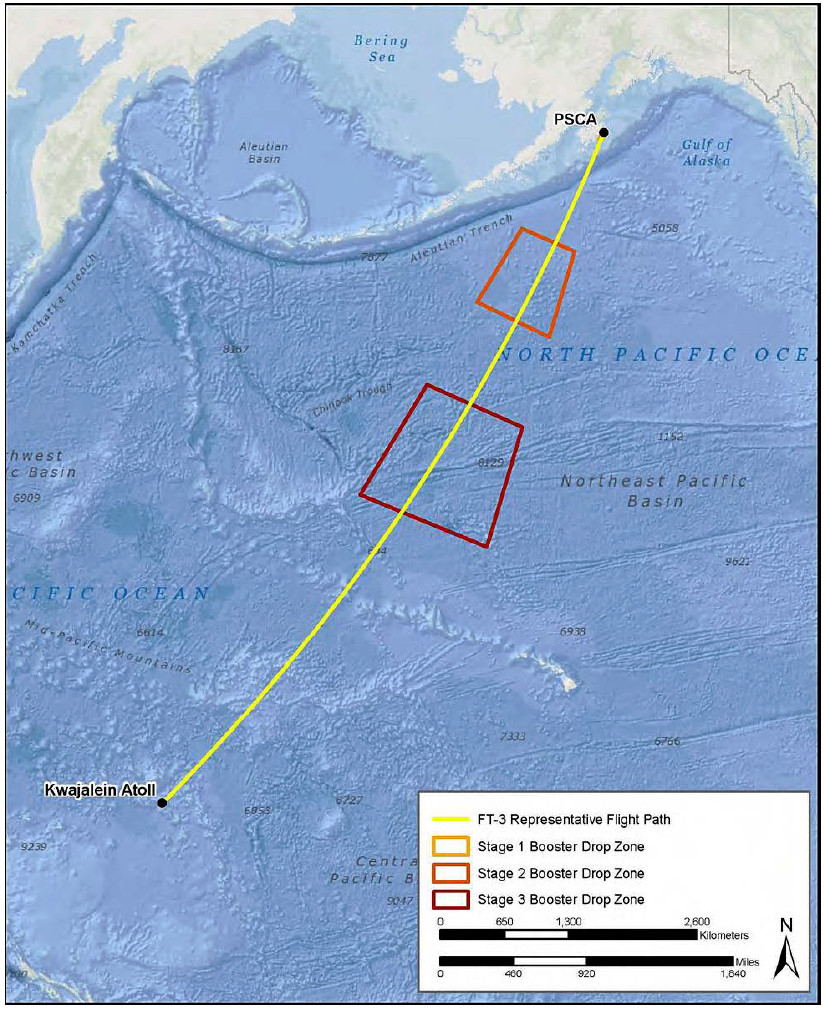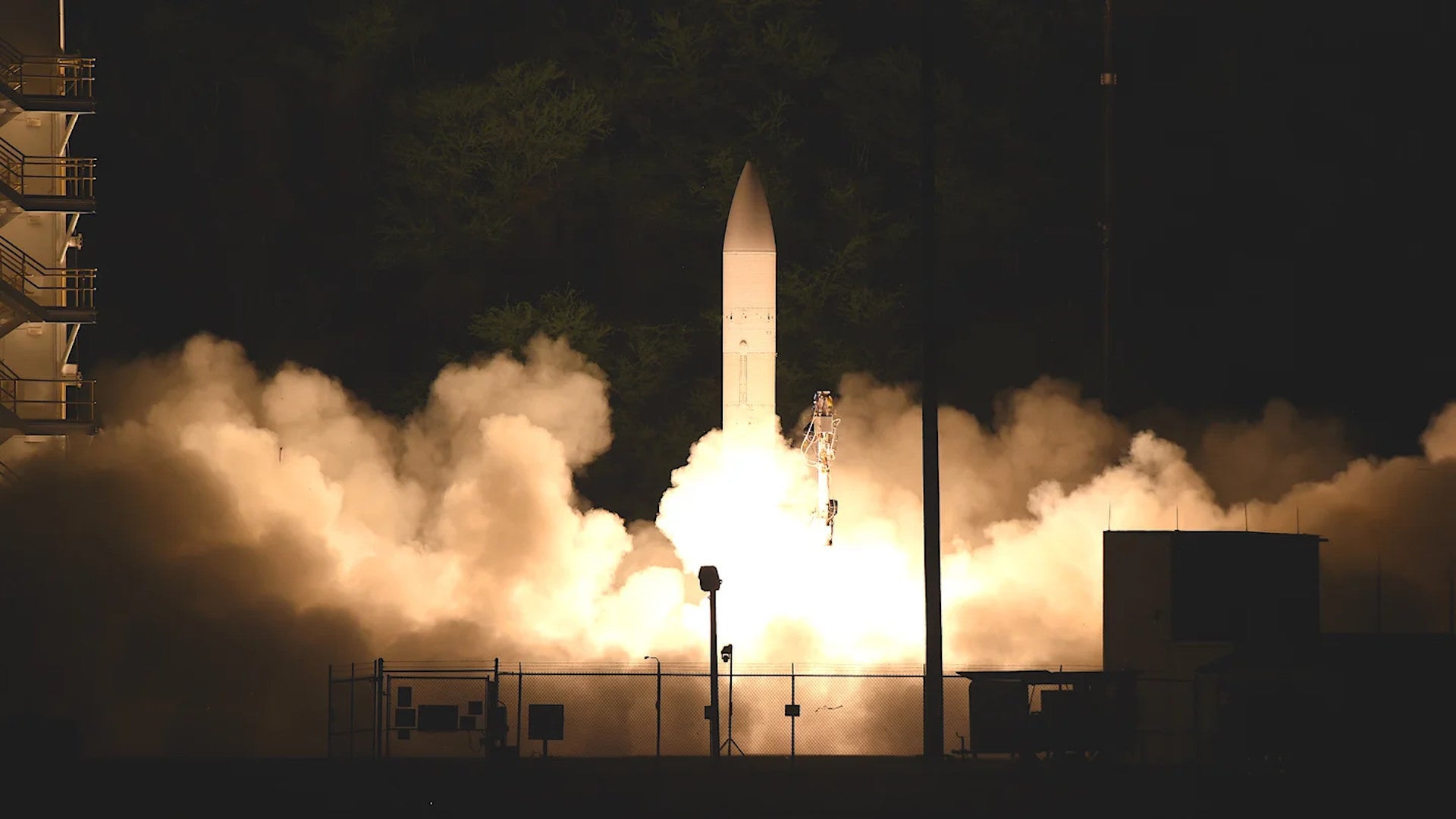Details are still limited, but the Pentagon has confirmed that a U.S. military test today of a long-range hypersonic weapon from Alaska has failed. There are reports that the system being tested was the missile design that will be used in the U.S. Army’s Dark Eagle and the U.S. Navy’s Intermediate-Range Conventional Prompt Strike weapon systems. But it is uncertain that is the case considering where this test took place, and an entirely separate booster stack or even different hypersonic payload may have been used. This all follows an earlier official statement about three successful tests yesterday related to the development of that common Army-Navy weapon.
Reuters was first to report on this failed test, which was conducted from the Pacific Spaceport Complex-Alaska on Kodiak Island in that state. Other outlets are now reporting many of the same basic details, but exactly what was being tested and how it failed remain unclear.
“A booster rocket with a hypersonic glide body attached failed to launch today during a launch test at Kodiak, Alaska says a U.S. official,” ABC News’ Luis Martinez wrote on Twitter. This raises questions about whether the missile even left the pad during this test.
The Army and Navy have been working together on a hypersonic weapon since 2017, with the services planning to fire it from ground-based launchers and ships and submarines, respectively. Aviation Week‘s Steve Trimble has reported that this failed test was the first attempt to test a prototype of this common missile, which consists of a two-stage booster with a hypersonic boost-glide vehicle on top. Both services have previously conducted tests of the vehicle itself using other boosters.
The Army and Navy had previously said they intended to begin flight testing their common hypersonic weapon in the 2022 fiscal year, which began on Oct. 1. The Army had also said earlier this year that at least some of this testing would be carried out from Kodiak.
The Pentagon had earlier confirmed to Reuters that it conducted three successful tests of “advanced hypersonic technologies, capabilities, and prototype systems” related to Dark Eagle and the Intermediate-Range Conventional Prompt Strike (IRCPS) weapon system “in a realistic operating environment.” Sandia National Laboratories, which designed the hypersonic boost-glide vehicle that the Army and Navy are using on their common missile, led those tests, which took place at NASA’s Wallops Flight Facility in Virginia.
Indications of an impending test from Kodiak, which has also been used for missile-defense-related testing in the past, had arisen earlier this week in the form of alerts to civilian pilots and mariners about potential hazards. Those notices indicated that Kodiak was the launch point and that the impact area would be near or within the boundary of the Ronald Reagan Ballistic Missile Defense Test Site, a U.S. Army-managed test range at Kwajalein Atoll in the Republic of the Marshall Islands.
The distance between these launch and impact points is significantly longer than the stated range of the common Army-Navy hypersonic missile. The Army has only said in the past that Dark Eagle will be able to hit targets out to a distance of “greater than” 1,725 miles away. The distance between Kodiak and Kwajalein is around 4,000 miles.
This failed test also notably comes after reports that China has tested a new fractional orbital bombard weapon system that uses a hypersonic glide vehicle. News of those tests first broke on Sunday, with a second report coming out yesterday that said the Chinese had conducted two tests of this weapon system earlier this year, not one as had been initially reported. You can read more about what we know of this Chinese development here.
U.S. President Joe Biden also said yesterday that he was concerned by China’s new hypersonic weapon developments.
We will continue to update this story as more information becomes available.
Updated 6:20 PM EST:
U.S. Navy Lt. Cmdr. Tim Gorman, a Pentagon spokesperson, has provided the following statement regarding today’s failed test:
On Oct. 21, the Department of Defense conducted a data collection experiment from the Pacific Spaceport Complex-Alaska, Kodiak, AK, to inform the department’s hypersonic technology development. The test did not occur as planned due to a failure of the booster stack. The booster stack used in the test was not part of the hypersonic program and is not related to the Common Hypersonic Glide Body. The missile booster is used for testing purposes only. Program officials have initiated a review to determine the cause of the booster system failure to inform future tests. Experiments and tests – both successful and unsuccessful – are the backbone of developing highly complex, critical technologies at tremendous speed, as the department is doing with hypersonic technologies. Delivering hypersonic weapons remains a top priority, and the department remains confident that it is on track to field offensive hypersonic capabilities beginning in the early 2020s. This flight test is part of an ongoing series of flight tests as we continue to develop this technology.
From this statement, it remains unclear whether whatever this missile was actually left the launch pad. We still don’t know exactly what the reason for the booster stack’s failure was, either.
In addition, this statement raises questions about exactly what was under test today, especially if it is entirely unrelated to the Common Hypersonic Glide Body (C-HGB). This C-HGB is the boost-glide vehicle that will be used on Army and Navy’s common hypersonic missile.
It is possible that this could have been a test of something entirely new, which may not even necessarily be a weapon system. That it might not be directly related to Dark Eagle or IRCPS would also fit with the apparent expected range of the test that we had already noted.
Updated 7:00 PM EST:
It has been brought to our attention that the failed test may have been one known as Hypersonic Flight Test-3, or FT-3.
A report from earlier this year regarding a consultation between the National Marine Fisheries Service, part of the National Oceanic and Atmospheric Administration (NOAA), and the Army over possible violations of the Endangered Species Act that could result from FT-3, something that is generally an issue when it comes to testing at Kwajalein, says the following:
The proposed action involves launching a single developmental test missile (Hypersonic Flight Test-3, FT-3) from the Pacific Spaceport Complex Alaska (PSCA) on Kodiak Island, Alaska, which would travel across a broad ocean area (BOA) of the Pacific Ocean. The payload impact would be at the Ronald Reagan Ballistic Missile Defense Test Site (RTS) at Illeginni Islet in Kwajalein Atoll, Republic of the Marshall Islands (RMI) (Figure 1). The purpose of FT-3 is to demonstrate a reduction of risk for a longer-range payload system and the data collected from this flight would be used to improve performance prediction models of the system. The FT-3 is a flight test that will be similar to and a crucial step in the developmental process following the Flight Experiment-1 (FE-1) and Flight Experiment-2 (FE-2), which were flight tests conducted in 2017 and 2019, respectively.
The “Figure 1” referenced above is the map seen below, which aligns well with the navigational warnings that appear to have been issued in regard to today’s failed test. That map also makes clear that this test would involve a three-stage booster stack, rather than a two-stage one that will be used on the common Army-Navy hypersonic missile.

Flight Experiment-1 (FE-1) and Flight Experiment-2 (FE-2) are also mentioned in this passage from the report. FE-1 refers to a test of a hypersonic boost-glide vehicle using a booster fired from an unspecified Ohio class submarine in 2017. FE-2 was another hypersonic boost-glide vehicle test conducted in 2020 using a three-stage ground-launched STARS booster. Both of these tests have helped inform the development of what has since evolved into the Dark Eagle and IRCPS weapon systems.
Updated 7:30 PM EST:
The Navy has now released additional information on the earlier hypersonic tests at Wallops Island in Virginia. A trio of what were described as precision sounding rockets were used to carry out those “hypersonic experiments” in cooperation with the Navy’s Conventional Prompt Strike program office, the Army’s Hypersonic Program Office, the Pentagon’s Joint Hypersonic Transition Office, Sandia National Laboratories, Johns Hopkins University’s Applied Physics Laboratory, the Oak Ridge National Laboratory, the MITRE Corporation, and “several defense contractors,” according to an official release.
“During weapon system development, precision sounding rocket launches fill a critical gap between ground testing and full system flight testing,” the official release added. “These launches allow for frequent and regular flight testing opportunities to support rapid maturation of offensive and defensive hypersonic technologies.”
“This test is a vital step in the development of a Navy-designed common hypersonic missile, consisting of a Common Hypersonic Glide Body (CHGB) and booster, which will be fielded by both the Navy and Army with individual weapon systems and launchers tailored for launch from sea or land,” it continued. “The Department of Defense (DoD) successfully tested the CHGB on March 20, 2020. The Navy and Army will continue to work in close collaboration to leverage joint testing opportunities.”
Contact the author: joe@thedrive.com
